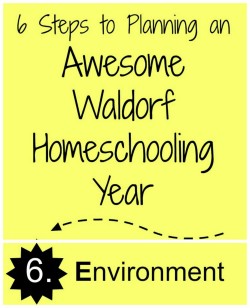In the 6 Steps to Planning an Awesome Waldorf Homeschooling Year, the final step is setting up your environment, the “E” in our acronym, BRIDLE.
 Step Six: Setting Up Your Waldorf Homeschool Environment
Step Six: Setting Up Your Waldorf Homeschool Environment
This can be such a fun step! You have already sketched out a block plan for the year in Step One, looked over Resources and established a weekly Rhythm in Step Two, chosen a practice for Inner Work in Step Three, created a daily Rhythm in Step Four, and begun your Lesson Planning in Step Five! Good job!!!
Action Step: And now it’s time to think about setting up your environment for homeschooling.
This post contains affiliate links for your convenience. You can read my full disclosure policy here.
What are the most critical supplies? Here’s my short list:
- bean bags (see this post for how to make your own: Movement Games)
- main lesson books or loose drawing paper
- manila paper & drawing paper for form drawing
- good watercolor paints (I like Stockmar paints best)
- good watercolor paper (Strathmore 140# paper is good)
- good crayons (again, I like Stockmar crayons best)
Of course, you will also need good stories, songs and verses that you’ve already been collecting as this planning process has moved along!
Here are some common questions:
Q: Should each child have his/her own supply of crayons?
A: If at all possible, yes! I like to have a basket of supplies for each child to “own.” In that basket, you could put crayons, both stick and block (the square Stockmar tin with some of each is great), scissors, colored pencils (if they are around age 9 or older), a glue stick, perhaps some drawing pencils and a eraser. Children love having their own supplies and can take responsibility for getting this basket off the shelf, putting everything back after lessons, and putting it away. If your budget does not allow for this and you have many children of school age, try figuring out a way to have them share in pairs. These items can make a great “first day of lessons” surprise!
Q: Do you think it’s best to have a dedicated homeschooling room or do our lessons in the dining room?
A: I actually prefer the dining room table for drawing and writing, and the living room for circle, singing, and stories! We do have a third floor that we have used at various phases for our lessons, but it seems so far removed from the “life” of the family that we were always hesitant to go up there and even I dragged my feet about doing lessons sometimes! We have supplies and books in cloth bins or baskets that keep everything neat on shelves in the dining room, as well as some dedicated drawers for paints and chalks and paper in our sideboard. My best advice is to clear the clutter and make space for homeschooling!
Q: Do you buy pre-made main lesson books or make your own?
A: We do some of both! Mixing it up is a good idea to stay out of the rut of doing every single block exactly the same. You don’t even have to make main lesson books for some blocks if lessons are getting tedious. It’s a good idea to fill up a book, so if you buy the pre-made main lesson books, be sure to plan accordingly. You could put all story lessons for the year into one book and all the math lessons into another. Making lesson book with just drawing paper is fun too and then you can put it together after the block is complete.
Q: Where do you get your paper?
A: I buy all of our paper locally (except for main lesson books). Paper can be one of the biggest expenses in Waldorf homeschooling! I like to get good water color paper that is 140# (Strathmore 300 series is good). Next is either drawing paper or purchased main lesson books. (I buy main lesson books from a Waldorf supplier. See possibilities on my Resources for Waldorf-Inspired Homeschooling – this is the most popular page on my website!) The drawing paper can be used for form drawing as well, and then compiled into a book at the end of the year. Inexpensive manila drawing paper is great for practicing form drawing.
Have fun with your 6 Steps to Planning an Awesome Waldorf Homeschooling Year! If you want more help with planning out your year with these six steps, check out the Plan It Out course, just one of the many masterclasses inside Inspired at Home.
All six steps spell the acronym BRIDLE:
- Step One: Blocks
- Step Two: Resources & Rhythm
- Step Three: Inner Work
- Step Four: Daily Rhythm
- Step Five: Lessons
- Step Six: Environment
Do you still have questions even after reading this series?
Check out my online course, Plan It Out., where I walk you through this process step-by-step.




One Comment